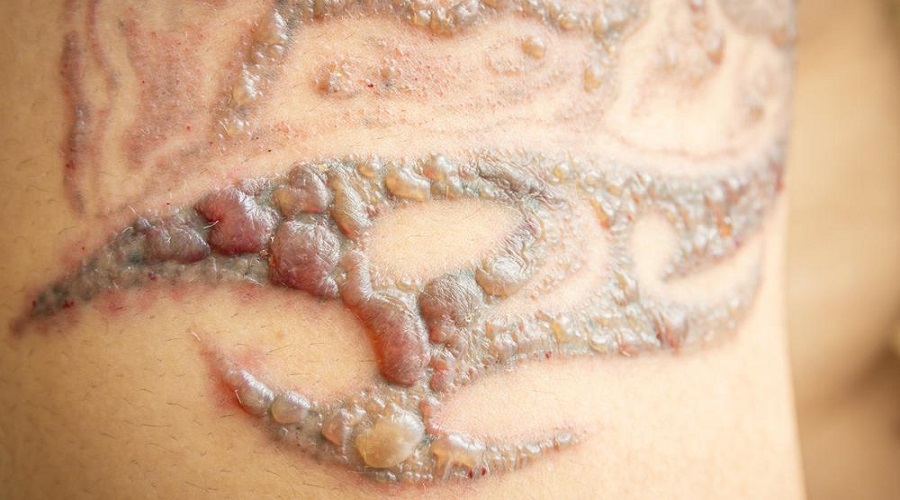There are a variety of methods for tattoo removal, and each comes with its own set of risks and side effects. Some common side effects of tattoo removal include itching, redness, swelling, and blistering. In some cases, people may also experience scarring.
The extent of the scarring will depend on the method used for tattoo removal as well as the person’s individual healing process.
If you’re considering getting a tattoo removed, you may be wondering if the process will leave scars. The answer to this question depends on a few factors, including the size and location of the tattoo, as well as the method used for removal.
Laser tattoo removal is generally considered to be the safest and most effective method for removing tattoos.
This type of removal uses pulses of light to break up the ink pigment, which is then absorbed by the body. There is a small risk of scarring with laser tattoo removal, but it is usually minimal and fades over time.
Some other methods of tattoo removal, such as surgical excision or dermabrasion, can be more invasive and may result in more noticeable scarring.
If you’re concerned about potential scarring from tattoo removal, be sure to discuss your concerns with your doctor or dermatologist before proceeding with any treatment.
Tattoo-removal procedures leave clients scarred for life
Do Tattoo Removal Marks Go Away?
If you’re considering tattoo removal, you may be wondering if the process will leave behind any marks. The good news is that, in most cases, tattoo removal marks are not permanent and will eventually fade away.
There are a few factors that can affect how noticeable tattoo removal marks are and how long they take to fade.
These include the size and location of the tattoo, the type of ink used, the number of treatments required, and your skin’s natural healing ability.
In general, smaller tattoos with lighter colors are easier to remove and will result in less visible scarring. Tattoos located on areas of the body that have a lot of movement (like hands or feet) may also be more likely to leave behind scars.
And finally, tattoos done with professional-grade inks tend to be easier to remove than those done with at-home kits.
The bottom line is that while tattoo removal marks are usually not permanent, there is no guarantee that they will completely disappear. If you’re concerned about scarring, be sure to discuss your concerns with your doctor or dermatologist before undergoing treatment.
Will My Skin Go Back to Normal After Tattoo Removal?
If you’re considering tattoo removal, you might be wondering if your skin will go back to normal afterwards. The good news is that, in most cases, it will!
However, there are a few things to keep in mind.
First of all, the amount of time it takes for your skin to heal and return to its normal state will depend on how many sessions of tattoo removal you undergo. Obviously, the more sessions you have, the longer it will take for your skin to heal between each one.
Secondly, the size of your tattoo will also affect how quickly your skin heals.
Smaller tattoos tend to heal faster than larger ones. And finally, the location of your tattoo can also play a role in healing time; tattoos on parts of the body that get a lot of sun exposure (like the arms or legs) usually heal faster than those in more hidden areas (like the back or chest).
So how long does tattoo removal normally take?
It really depends on all of these factors – but in general, most people see their tattoos significantly faded after 4-6 sessions. So if you’re patient and willing to commit to multiple treatments, there’s a good chance you’ll see your skin return to its pre-tattoo state!
Can a Tattoo Be Completely Removed?
Most people believe that tattoos are permanent, but this is not always the case. It is possible to remove a tattoo, though it may not be possible to remove it completely.
There are two main methods of tattoo removal: laser surgery and dermabrasion.
Laser surgery uses pulses of light to break up the ink in the tattoo, while dermabrasion uses a rotating wire brush or diamond fraise to sand off the top layer of skin where the tattoo is located.
Both methods can be effective, but they can also cause scarring. In some cases, it may be possible to cover up a tattoo with another tattoo.
If you’re considering removing a tattoo, talk to a dermatologist or plastic surgeon about your options and what to expect during and after treatment.
How Do You Prevent Scarring After Tattoo Removal?
If you’re considering tattoo removal, you may be wondering how to avoid scarring. While any kind of tattoo removal comes with the risk of scarring, there are some things you can do to minimize the chances of it happening.
First, it’s important to choose a reputable tattoo removal facility and technician.
A good facility will use lasers that are appropriate for your skin type and the ink color of your tattoo. They will also have experience in performing tattoo removal without causing scarring.
Second, follow all aftercare instructions carefully.
This includes keeping the treated area clean and moisturized. It’s also important to avoid sun exposure during the healing process as this can increase the risk of scarring.
If you do experience some Scarring after tattoo removal, there are treatments that can help reduce its appearance.
These include laser resurfacing, microdermabrasion, and topical treatments such as retinoids or corticosteroids.

Credit: elegancybeautybar.com
Does Tattoo Removal Hurt?
If you’re considering tattoo removal, you might be wondering how much it will hurt. The good news is that modern tattoo removal methods are generally very effective and relatively painless.
Laser tattoo removal is the most common method of tattoo removal.
It works by breaking up the ink pigments in your skin with pulses of laser light. The number of treatments you’ll need depends on the size, location, and color of your tattoo, but most people can expect to see significant results after just a few sessions.
The sensation of laser tattoo removal has been described as feeling like a rubber band snapping against the skin.
Some people report discomfort during treatment, but this is usually mild and short-lived. anesthesia or pain medication is typically not necessary.
After treatment, your skin will be sore and red for a few days, but this should quickly resolve itself.
You’ll likely see some immediate fading of your tattoo after each treatment session, but it can take several weeks or months for the full effect to be seen.
If you’re looking for a safe and effective way to remove a unwanted tattoo, laser tattoo removal is definitely worth considering!
Does Laser Tattoo Removal Cause Cancer?
Laser tattoo removal is a popular choice for those who want to get rid of their ink. But does it cause cancer? The short answer is no, laser tattoo removal does not cause cancer.
However, there are some potential risks associated with the procedure that you should be aware of.
The most common risk associated with laser tattoo removal is skin irritation. The laser can cause burns, blisters, and scars.
In rare cases, the laser can also cause a change in skin pigmentation called hypopigmentation or hyperpigmentation. These changes usually resolve on their own but can be permanent in rare cases.
Another potential risk of laser tattoo removal is infection.
The procedure creates an open wound on the skin that can become infected if it’s not cared for properly. Be sure to follow your doctor’s instructions for care after the procedure to reduce your risk of infection.
Overall, laser tattoo removal is a safe and effective way to get rid of unwanted ink.
Talk to your doctor about the potential risks and benefits before getting the procedure done.
Laser Tattoo Removal
Laser tattoo removal has become a popular choice for people who want to get rid of their unwanted ink. The procedure uses laser energy to break up the ink particles in the tattoo, which are then absorbed by the body. There are a few things to consider before getting laser tattoo removals, such as the type of laser that will be used, the number of treatments needed, and the side effects.
Be sure to consult with a qualified professional to make sure that laser tattoo removal is right for you.
Conclusion
There are a lot of people who are interested in getting rid of their tattoos. However, they may be worried about the possibility of scarring. While it is true that tattoo removal can leave scars, there are a few things you can do to minimize the risk.
First, make sure you go to a reputable tattoo removal specialist. They will be able to give you the best treatment and help reduce the chances of scarring.
Second, follow all aftercare instructions carefully.
This includes keeping the area clean and moisturized.
Third, consider using laser tattoo removal. This method uses pulses of light to break up the ink under your skin without causing damage to the surrounding tissue.
It is generally considered to be much less likely to cause scarring than other methods such as surgery or dermabrasion.




